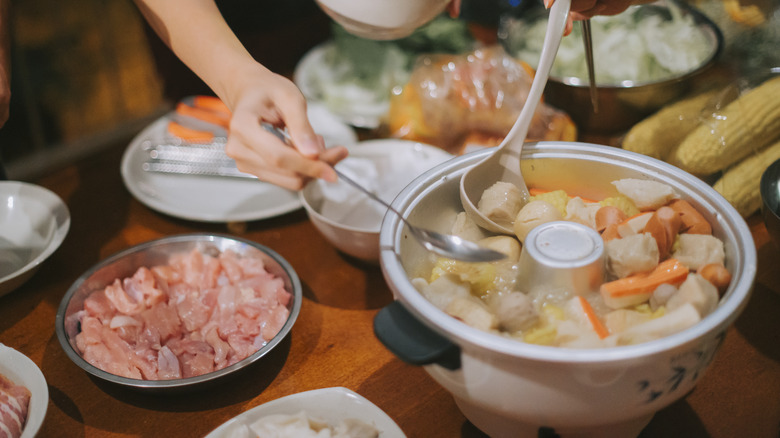When Making Hot Pot At Home, A Clear Broth Is A Happy Broth
As the culinary equivalent of a warm hug, hot pot is always a crowd-pleaser. Partaking in Chinese hot pot usually involves huddling in a group around a pot of simmering broth and cooking your own chosen ingredients in it. Components usually include vegetables, noodles, and meat. The endeavor is impressive, to be sure, and may seem too overwhelming to try at home. But when broken down into its parts, making hot pot at home is achievable. Cooks should just adhere to the well-known tenet of keeping your broth clear.
Spicy broth is of course a wildly accepted flavor in many hot pot circles, but for those with a more sensitive taste palate, clear broth may be preferable. Mild broth also has other benefits in addition to accommodating lower spice tolerance. Hot pot broth should be lightly seasoned so it doesn't overpower the ingredients. With such a mild taste, the stock becomes more flavorful the longer it simmers with the delicious juices of meat and vegetables. There are many prepackaged varieties that you can buy in stores, but for the clearest broth for your hot pot gathering, try making it from scratch.
Making broth from scratch
Making homemade broth or stock is undoubtedly time consuming, but the benefits far outweigh the costs when it comes to flavor. Cooking influencer TJ Lee recommended her tricks of the trade to The Kitchn while making hot pot for a Thanksgiving celebration.
"What you wanna do first is we actually want to clean the bone as much as possible, because we want the clearest broth," Lee explained. The cleaning process includes putting the animal bones — typically pork or poultry — in a bowl of cold water for 30 minutes. While it sits in the bath, the water draws the blood out of the bones. After the time has elapsed, start simmering the bones on the stove to remove any residual material. Skin will rise to the surface of the liquid, which you can scoop out so the broth will remain clean. Then dump the water and wash the remainder of the skin under the faucet. Finish the process by frying the bones for a few minutes before adding boiling water. Bring it to a simmer and let the bones cook for about an hour. This preparation will ensure that you will have broth that isn't plagued with over-processing and will yield the best results.
Best tips for hot pot broth
There are also the typical do's and don'ts of ensuring your hot pot broth is as clean as possible. One of the danger zones is during the simmering process. You may be tempted to put a lid on the pot to capitalize on cooking time, but make sure you do it correctly. A fully covered pot can run the risk of condensation, which can impact your broth quality. Just as with overseasoning, moisture from the pot won't make the broth as clear as it can be, which is instrumental in tasting the flavors from other ingredients. Instead of fully covering the pot, let some steam escape while the bones are simmering so condensation doesn't drop into the pot.
For this reason, buying stock from the store can also be iffy. While many websites and experts find no issue with buying just-add-water broth, it won't be the cleanest experience for tasting your soup. Any time you buy stock at the store, you don't quite know what has gone into the concoction. Store-bought also doesn't reduce as well as home batches do. Making your own basic chicken stock for any occasion is preferable since you can control what your soup base will contain. Quality control is in your hands as long as you make your broth from scratch.


